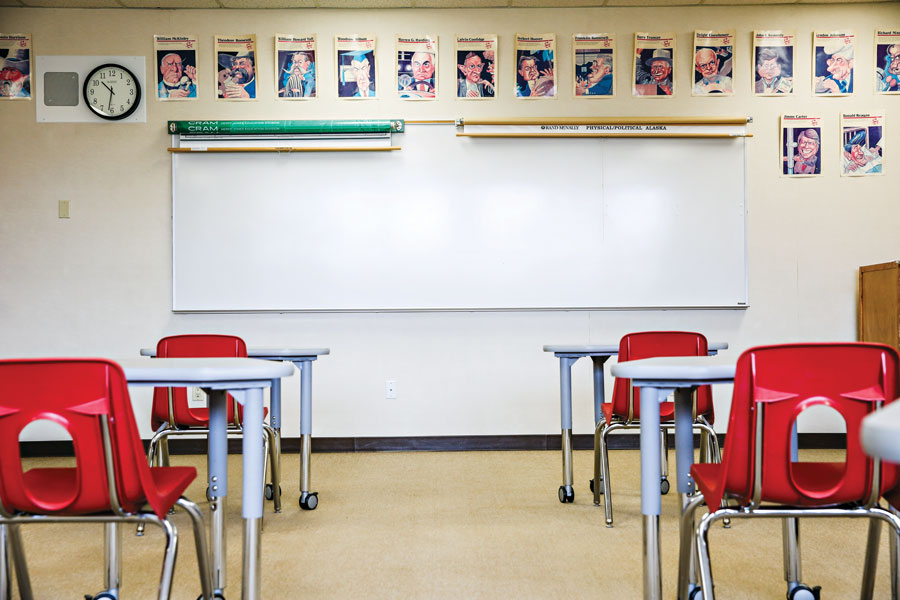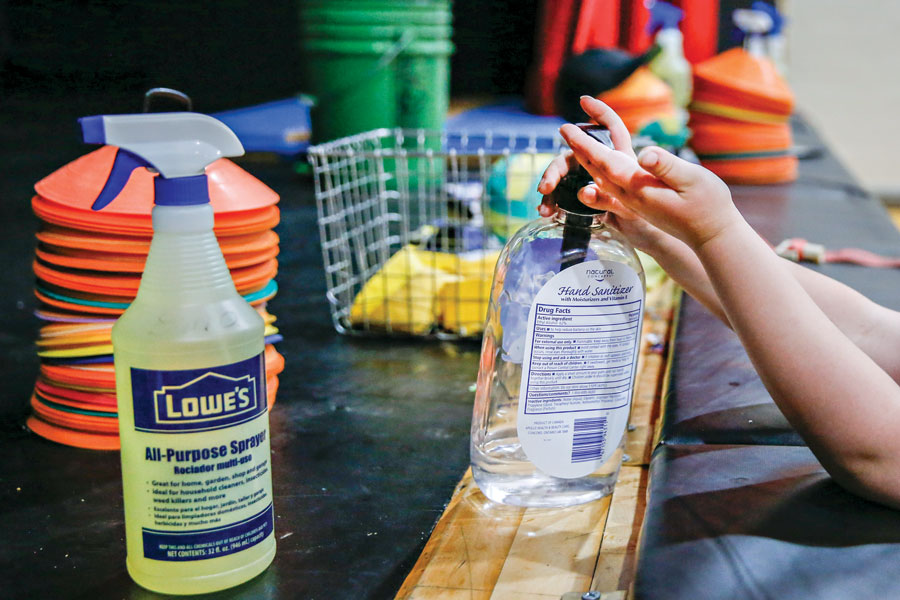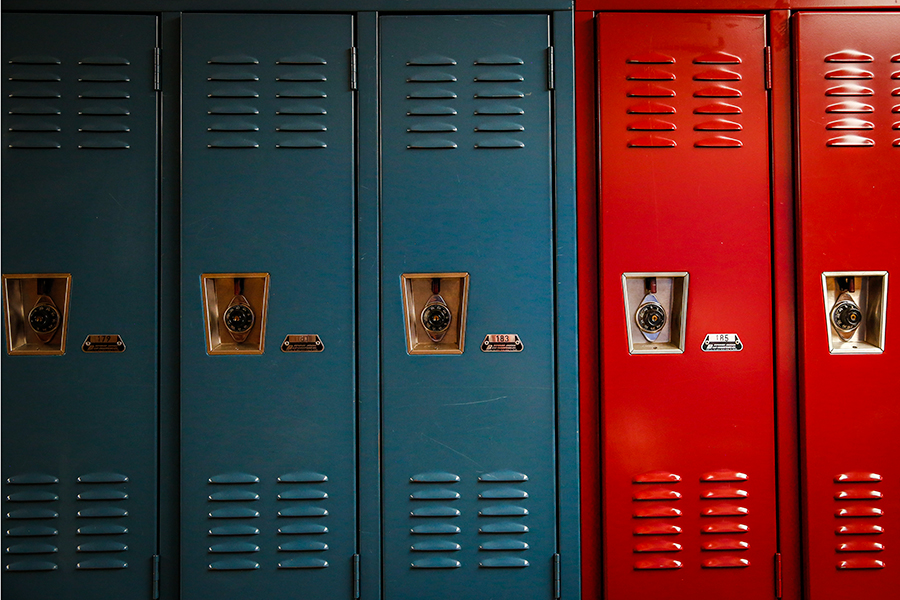The Reopening Riddle
As local education officials unveil plans to fully open school doors this fall, they are navigating uncharted terrain, sorting through divergent recommendations and complicated questions with no blueprint or easy answers
By Myers Reece
At noon on July 2, Montana Superintendent of Public Instruction Elsie Arntzen, the state’s chief education official, issued a reopening plan for the upcoming school year that begins next month. A half hour later, Gov. Steve Bullock’s office emailed out its own separate plan, with neither side seeing the other’s document before release.
Then on July 7, President Donald Trump announced he will “put pressure on the governors and the schools to reopen.” The following day, Trump threatened to cut off federal funding for schools that don’t open their doors to in-person instruction and criticized reopening guidelines from the Centers for Disease Control and Prevention (CDC), further illuminating the issue’s thorny political morass.
Meanwhile, a wide array of local, state and federal entities, including public health and education organizations, have issued recommendations for schools to safely reopen, some mirroring each other, others diverging markedly and a number shifting with evolving science and COVID-19 conditions.
In both the foreground and background of these discussions are the economy and society at large: parents can go to work if their children are in school, and the broader implications of education’s efficacy, whether brick and mortar or remote, stretch across the cultural and financial spectrum, in both the short and long term.
Underlying everything is the most important consideration: human health.
All of which creates a dizzying atmosphere for the people in Montana who are ultimately responsible for deciding how to proceed this fall: local school officials and board members who didn’t receive a pandemic handbook when they took the positions.
“There are a lot of recommendations from various groups, sometimes conflicting, and we’ve been sorting through all the information and we’ve spent a lot of time trying to narrow down the scope of what we can do and what we should do,” said Bigfork Superintendent of Schools Matt Jensen, who is also president of the Montana Association of School Superintendents’ Northwest Region.
But Jensen added that “the lack of firm direction has been a blessing and curse,” with the blessing being local control and flexible decision-making to craft plans that best serve each district’s students and community, a sentiment echoed by Evergreen Superintendent Laurie Barron.
“The absence of specific directives and guidance has been challenging and we have at times wished for that,” Barron said. “But I have to be honest, in the same breath, if that guidance came out and if it was in direct conflict with what the students and staff and families of Evergreen need, I would be bound to that guidance.”
“Having all those viewpoints, while at times it’s challenging and conflicting, it also gives us opportunities to learn from those different viewpoints,” she added.

Public school districts across Montana are presenting reopening plans to their boards of trustees for the 2020-21 school year. Bigfork’s school board was the first in the Flathead Valley to approve a draft on June 29, followed by Evergreen on July 13. School boards in Kalispell, Whitefish and Columbia Falls all had reopening plans on their agenda this week, either scheduled for review or action.
The region’s superintendents have been working closely together and with local health officials as they navigate uncharted terrain, and the districts’ proposals have comparable formats with individualized details, all based on phases of the governor’s reopening plan, as are the plans of private institutions such as Whitefish Christian Academy and Stillwater Christian School.
The valley’s three biggest school districts — Kalispell, Columbia Falls and Whitefish — are heading into this unparalleled year with new superintendents who started on the job this month.
School administrators are currently operating on the expectation that Montana will still be in Phase 2 when the semester starts next month, which means local school districts — assuming the plans are approved by their respective boards — will fully open to in-person instruction while offering remote learning to students who stay home due to health and safety concerns.
Students are limited to groups no larger than 50 in Phase 2, requiring multiple lunch locations and complicating assemblies and other occurrences. Local districts are proposing non-static groups, as allowed by the state, meaning students can mix and rotate through different classes as normal throughout the day. Static groups, on the other hand, stay together all day without mixing with other students, dramatically altering class scheduling and essentially ruling out high school sports and activities, although districts elsewhere in Montana are considering that option, at least for certain grades.
Local plans account for the possibility of returning to more restrictive phases, including facility closures and full remote learning, and also factor in the potential for improvements in COVID-19 conditions and advancement to less restrictive phases. Jensen said “success could hinge” on districts’ ability to transition from phase to phase without significant disruptions.
The recently unveiled reopening plans provide roadmap outlines for which more details will be filled in and tweaked through a public process, including family surveys and comments, in the coming weeks.
“The most important thing is being flexible and nimble because things could change, not only once school starts but between now and then,” Columbia Falls Superintendent Dave Wick said.
If still in Phase 2 as currently anticipated, sports and activities in the Flathead Valley, including high school football, are slated to move forward, with a range of precautions in place in accordance with Montana High School Association and public-health guidelines on factors such as travel, crowd sizes and health protocols.
Jensen said activities are one of several specific areas for which superintendents would like clearer guidance from state and health officials. The others include face coverings, transportation and, especially, criteria for triggering the transition into a different phase.
“The clarity on what would warrant those transitions has been absent,” Jensen said. “And it seems to me that those are pretty universal questions that would likely be best answered on the state level. Right now there’s a vacuum where that information doesn’t exist.”
School officials say their central concern throughout the planning process has been the health and safety of students, families, teachers and staff, although the myriad logistics and weighty judgment calls are loaded with potentially controversial complexities.
“Number one is we love these people and we want to maintain a safe and healthy and welcoming environment,” Jensen said. “Number two is we’re schools and we’re in the business of education: we have to keep kids’ learning at the forefronts of our plans.”
In general, children are less likely to become symptomatic or experience severe illness from COVID-19, although the disease can hospitalize and kill kids, and there’s growing evidence of links between the disease and other serious complications, including multisystem inflammatory syndrome. The potential later-life impacts are also unclear.

While one of the biggest concerns regarding school reopening is the potential for virus spread, the role of children in transmission is hazy, with the American Academy of Pediatrics (AAP) saying they “may be less likely to become infected and to spread infection.” Studies in other countries suggest that high school-aged kids may become infected and spread the disease at higher rates than younger children.
Acknowledging that “many questions remain,” the AAP, the nation’s most influential pediatric organization, laid out a position in a school reopening document updated in late June that “strongly advocates that all policy considerations for the coming school year should start with a goal of having students physically present in school.”
“Although children and adolescents play a major role in amplifying influenza outbreaks, to date, this does not appear to be the case with SARS-CoV-2,” the group states.
In its reasoning, the AAP notes the importance of in-person learning and evidence of detrimental educational, social and health impacts from closures, including disruption of supportive services resulting in social isolation, which makes it “difficult for schools to identify and address important learning deficits as well as child and adolescent physical or sexual abuse, substance use, depression, and suicidal ideation.” The AAP also points to food security and physical activity.
Jensen of Bigfork is awaiting the results of a family survey that will help the district refine details based on information that includes how many guardians are comfortable sending their kids back to in-person instruction, with the expectation valley-wide that most families will but a certain percentage won’t, perhaps not until a COVID-19 vaccine is developed.
The Bigfork questionnaire also asked families to rank their preferred methods of mixing in-person and remote learning: in-person learning one week and remote the following week, in-person on certain days and remote on others, or full-time remote. Other districts are conducting similar surveys.
Under the districts’ Phase 2 plans, there will be stringent cleaning and health protocols in place, including frequent sanitation of surfaces and equipment and rigorous emphasis on hand hygiene. In Bigfork, students will have their temperature taken each morning as they arrive at multiple entry points to reduce congestion. Bigfork and Evergreen may also mandate face-covering zones in common and high-traffic areas.
Whitefish is proposing health screening and hand washing upon entry, and the plan calls for requiring face coverings “for students and staff in common areas, high traffic areas, and during passing times.” Kalispell’s draft proposes health screening and hand sanitizing upon entry “when feasible” and says face coverings “may be required” in certain school areas and during passing times, as well as on buses.
Reopening plans must be nuanced and elastic enough to account for the wildly divergent needs of an entire student base. What works for high school seniors won’t necessarily for kindergarteners.
Kalispell Superintendent Micah Hill said practicality is inescapably a consideration when formulating rules, echoing guidance from medical organizations such as Children’s Hospital Colorado and the AAP. For instance, the AAP said testing all students “prior to the start of school is not feasible in most settings at this time.”
“Even in places where this is possible, it is not clear that such testing would reduce the likelihood of spread within schools” because the viral-detection tests only offer information for a “specific moment in time,” the AAP states.
The guidelines also account for different conditions by state and community. Montana has among the country’s lowest per-capita rates in positive cases, hospitalizations and deaths, and some counties don’t have a single confirmed case. But the state is now experiencing a spike in COVID-19 cases as the school near years.
Hill acknowledges that in a district with 6,000 students and hundreds of employees, plus a number of rural feeder districts impacted by his decisions, there will inevitably be unhappy stakeholders no matter what choices are made.
“If I say we’re opening up schools 100%, I’m going to have people mad at me,” Hill said. “If I say we’re closing school and going all remote, people are going to be mad. If I say we’re going to require face masks, people are going to be mad. That’s where we’re at in terms of the polarization of the topic.”
“You get the picture of how complicated this all becomes when you’re trying to create a plan for how you’re going to reopen school,” he added.
Jensen of Bigfork also noted the financial impacts of purchasing sufficient personal protective equipment, implementing temperature checks, increasing sanitation and other measures.
“That’s a serious riddle we’re going to have to solve: ‘How do you put all these pieces in place and afford it?’” he said.
Amanda Curtis, president of the Montana Federation of Public Employees (MFPE), said much-needed financial relief for schools is proposed in the latest pandemic stimulus bill, called the Heroes Act, which passed the U.S. House of Representatives but hasn’t yet received a vote in the Senate. The MFPE was involved in developing the governor’s reopening guidelines, a process led by Lieutenant Gov. Mike Cooney.

Gene Marcille, a Columbia Falls teacher who has been in education for 37 years, is head of the Columbia Falls teacher’s union and chair of the MFPE’s northwestern region. Marcille lamented that the reopening conversation has been politicized across the country, and points out that COVID-19 infections are higher now, in Montana and nationwide, than when schools were closed in the spring.
“This is unprecedented and we are in a pandemic — it’s serious,” Marcille said, adding that the question of whether to even open at all should be on the table. “It’s unfortunate it’s become a political question when it really should be about the health and safety of students and staff and faculty.”
Marcille says Montana school districts did a great job with online instruction during the spring under difficult circumstances but wishes there had been more concerted efforts to strengthen remote capacity over the summer. As an educator, he believes in-person teaching is the best model, but he questions its sustained viability and prudence amid the pandemic. For one, he wonders what will happen in the event of a virus outbreak at a school.
“From my perspective, we should be spending more time doubling down on online learning and be prepared to do that for another period of time, maybe a semester,” he said. “I wish there was more of a sense of, ‘Let’s be preparing to do it again but even do a better job.’”
Administrators are also mulling the potential ripple effects of COVID-19 detection in school. The county would shut down a school for two to five days if a positive case was confirmed, at which point the facility would be thoroughly cleaned and disinfected and contact tracers could complete their duties. It’s likely that some families wouldn’t send their kids back upon reopening.
“Then what happens if we come back and another kid gets sick?” Hill said. “Are we just bouncing in and out of school, and where does it all stop?”
Marcille hopes to see more clarity regarding protections for staff and faculty, as well as workflow and workload for teachers who are now being asked to implement both remote and in-class instruction, rather than strictly remote as in the spring.
“I’m afraid of what that’s going to look like,” he said of the hybrid model.
Bigfork and Whitefish plan to adopt synchronous teaching for remote learning, which could help streamline the hybrid model. In Bigfork’s case, that means teachers will hold in-person classes and also have periods set aside in the day to administer group online courses with remote students, through platforms such as Zoom or Google Meet.
Synchronous teaching could also take the form elsewhere of live-streaming the in-person classes, which is a fallback option in Bigfork, although Jensen said that model is less desirable because it turns remote students into viewers rather than participants. Kalispell’s draft doesn’t identify synchronous or asynchronous, and Hill noted the complexities of those decisions in such a huge district.
Beyond teaching models and responsibilities, Marcille worries about the livelihoods and health of faculty and staff, including those more at risk due to age or underlying health problems, and those living with someone who has compromised health.
“I have people come to me asking, ‘What are we going to do? Do we have to go to work?’” Marcille said. “Unfortunately my answer to them is, ‘We’re in a wait-and-see mode.’”
“I’m super proud of the effort teachers make, all the time and with what we’re seeing now,” he added. “I have complete confidence that teachers are going to figure out what the best thing is going to be for their students, but at the same time we need to think about what’s best for them, what works for them.”
Educators are protected under federal laws such as the Families First Coronavirus Response Act, and the local district plans offer accommodations for students and staff required to quarantine due to the virus. Protocols are murky for a number of scenarios, however, including if an employee feels unsafe but doesn’t have a written doctor’s recommendation to avoid work.
“We have members who are afraid to go back to work just like there are parents who are afraid to send their kids,” Curtis of the MFPE said. “There are a lot of members with anxiety.”
Curtis said clarifications and protections would be addressed at the district level, with local unions reviewing reopening proposals and voicing input.
“Members will look at the plan and decide where to fix the bargaining agreement and go from there,” she said.
As administrators, board members, families and stakeholders traverse an educational landscape without precedent, Barron, the Evergreen superintendent, said the lessons absorbed along the journey will ultimately prove rewarding, as hard as it all feels right now.
“The reality is this is not fun; this is not enjoyable,” Barron said. “I never took a class on how to lead an entire school district through a pandemic. These are tough times and we’re working harder than we’ve ever worked. It’s the most challenging time of my career.”
“But it’s our current reality, and taking a negative approach doesn’t help,” she continued. “We have to be positive and find the opportunities to do the very best for our students and staff. I’ve loved watching the growth and collaboration, the creativity, the innovation, the input from parents, the ‘have-you-thought-of-this’ conversations. We’re all growing and learning from this.”